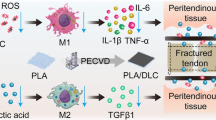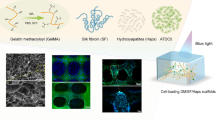Abstract
Purpose
The fixation and incorporation of ruptured rotator cuff tendon to bone is a major concern in rotator cuff repair surgery. Rotator cuff repair usually fails at the tendon–bone interface, especially in case of large or massive tears. To enhance tendon–bone healing, an injectable hydrogel made with periosteal progenitor cells(PPCs) and poly (ethylene glycol) diacrylate (PEGDA) tethered with bone morphogenic protein-2(BMP-2) was developed to encourage extracellular matrix synthesis for tendon-to-bone healing in rotator cuff repair.
Methods
The infraspinatus tendon was cut from the greater tuberosity and repaired through a transosseous tunnel with the injectable progenitor cell-BMP-2 hydrogel applied between the tendon–bone interface. The injectable hydrogel was prepared from 10% poly (ethylene glycol) diacrylate (PEGDA) containing 0.05% of the photoinitiator. BMP-2 tethered with poly(ethylene glycol) (PEG) was blended to the hydrogel. Rabbit periosteal progenitor cells (PPCs) isolated from periosteum were mixed with hydrogel and injected on the tendon–bone interface. Ultraviolet radiation (365 nm) was applied for 60 s to photopolymerize the injection and solidify the hydrogel. The rabbits were killed at 4 and 8 weeks. The morphological characteristics of the healing tendon-to-bone interface were evaluated by histological and immunohistochemical methods. The biomechanical test was done to determine healing attachment strength.
Results
At both the 4- and 8-week killing, histological analysis of the tendon–bone interface showed an increasing fibrocartilage and bone layer formed in the tendon–bone interface in PEGDA group. At 4 weeks, fibrocartilage-like tissue was observed in a focal area. At 8 weeks, further matrix deposition occurred with fibrocartilage formation in the tendon–bone junction, and bone formation appeared near host bone. Immunohistochemistry revealed the presence of aggrecan and type II collagen. Biomechanical testing revealed a higher maximum pull-out load at all time points with a statistically significant difference at 4 and 8 weeks postoperatively.
Conclusion
PEGDA hydrogel was approved as an adequate matrix for the encapsulation of cells and signal factor, and as an effective local delivery method to the tendon–bone interface through injection and photopolymerization. The PPCs-BMP2-hydrogel provides a powerful inductive ability between the tendon and the bone and enhances tendon–bone healing through the neoformation of fibrocartilage.








Similar content being viewed by others
References
Augustin G, Antabak A, Davila S (2007) The periosteum. Part 1: anatomy, histology and molecular biology. Injury 38:1115–1130
Badhe SP, Lawrence TM, Smith FD, Lunn PG (2008) An assessment of porcine dermal xenograft as an augmentation graft in the treatment of extensive rotator cuff tears. J Shoulder Elbow Surg 17:35S–39S
Baysal D, Balyk R, Otto D, Luciak-Corea C, Beaupre L (2005) Functional outcome and health-related quality of life after surgical repair of full-thickness rotator cuff tear using a mini-open technique. Am J Sports Med 33:1346–1355
Burkhart SS, Diaz Pagan JL, Wirth MA, Athanasiou KA (1997) Cyclic loading of anchor-based rotator cuff repairs: confirmation of the tension overload phenomenon and comparison of suture anchor fixation with transosseous fixation. Arthroscopy 13:720–724
Chang CH, Chen CH, Su CY, Liu HT, Yu CM (2009) Rotator cuff repair with periosteum for enhancing tendon-bone healing: a biomechanical and histological study in rabbits. Knee Surg Sports Traumatol Arthrosc 17:1447–1453
Chen CH, Chen WJ, Shih CH, Chou SW (2004) Arthroscopic anterior cruciate ligament reconstruction with periosteum-enveloping hamstring tendon graft. Knee Surg Sports Traumatol Arthrosc 12:398–405
Chen CH, Liu HW, Tsai CL, Yu CM, Lin IH, Hsiue GH (2008) Photoencapsulation of bone morphogenetic protein-2 and periosteal progenitor cells improve tendon graft healing in a bone tunnel. Am J Sports Med 36:461–473
de Jong DS, Steegenga WT, Hendriks JM, van Zoelen EJ, Olijve W, Dechering KJ (2004) Regulation of Notch signaling genes during BMP2-induced differentiation of osteoblast precursor cells. Biochem Biophys Res Commun 320:100–107
Derwin KA, Codsi MJ, Milks RA, Baker AR, McCarron JA, Iannotti JP (2009) Rotator cuff repair augmentation in a canine model with use of a woven poly-L-lactide device. J Bone Joint Surg Am 91:1159–1171
Gazielly DF, Gleyze P, Montagnon C (1994) Functional and anatomical results after rotator cuff repair. Clin Orthop Relat Res 304:43–53
Gerber C, Fuchs B, Hodler J (2000) The results of repair of massive tears of the rotator cuff. J Bone Joint Surg Am 82:505–515
Goradia VK, Mullen DJ, Boucher HR, Parks BG, O’Donnell JB (2001) Cyclic loading of rotator cuff repairs: a comparison of bioabsorbable tacks with metal suture anchors and transosseous sutures. Arthroscopy 17:360–364
Goutallier D, Postel JM, Gleyze P, Leguilloux P, Van Driessche S (2003) Influence of cuff muscle fatty degeneration on anatomic and functional outcomes after simple suture of full-thickness tears. J Shoulder Elbow Surg 12:550–554
Gulotta LV, Rodeo SA (2009) Growth factors for rotator cuff repair. Clin Sports Med 28:13–23
Harris MT, Butler DL, Boivin GP, Florer JB, Schantz EJ, Wenstrup RJ (2004) Mesenchymal stem cells used for rabbit tendon repair can form ectopic bone and express alkaline phosphatase activity in constructs. J Orthop Res 22:998–1003
Harryman DT 2nd, Mack LA, Wang KY, Jackins SE, Richardson ML, Matsen FA 3rd (1991) Repairs of the rotator cuff. Correlation of functional results with integrity of the cuff. J Bone Joint Surg Am 73:982–989
Hashimoto Y, Yoshida G, Toyoda H, Takaoka K (2007) Generation of tendon-to-bone interface “enthesis” with use of recombinant BMP-2 in a rabbit model. J Orthop Res 25:1415–1424
Jost B, Pfirrmann CW, Gerber C, Switzerland Z (2000) Clinical outcome after structural failure of rotator cuff repairs. J Bone Joint Surg Am 82:304–314
Ju YJ, Muneta T, Yoshimura H, Koga H, Sekiya I (2008) Synovial mesenchymal stem cells accelerate early remodeling of tendon-bone healing. Cell Tissue Res 332:469–478
Kawabata M, Imamura T, Miyazono K (1998) Signal transduction by bone morphogenetic proteins. Cytokine Growth Factor Rev 9:49–61
Kessler KJ, Bullens-Borrow AE, Zisholtz J (2002) LactoSorb plates for rotator cuff repair. Arthroscopy 18:279–283
Klepps S, Bishop J, Lin J, Cahlon O, Strauss A, Hayes P, Flatow EL (2004) Prospective evaluation of the effect of rotator cuff integrity on the outcome of open rotator cuff repairs. Am J Sports Med 32:1716–1722
Koh JL, Szomor Z, Murrell GA, Warren RF (2002) Supplementation of rotator cuff repair with a bioresorbable scaffold. Am J Sports Med 30:410–413
Liu HW, Chen CH, Tsai CL, Hsiue GH (2006) Targeted delivery system for juxtacrine signaling growth factor based on rhBMP-2-mediated carrier-protein conjugation. Bone 39:825–836
Liu HW, Chen CH, Tsai CL, Lin IH, Hsiue GH (2007) Heterobifunctional poly(ethylene glycol)-tethered bone morphogenetic protein-2-stimulated bone marrow mesenchymal stromal cell differentiation and osteogenesis. Tissue Eng 13:1113–1124
Mann BK, Schmedlen RH, West JL (2001) Tethered-TGF-beta increases extracellular matrix production of vascular smooth muscle cells. Biomaterials 22:439–444
Mansat P, Cofield RH, Kersten TE, Rowland CM (1997) Complications of rotator cuff repair. Orthop Clin North Am 28:205–213
Oguma H, Murakami G, Takahashi-Iwanaga H, Aoki M, Ishii S (2001) Early anchoring collagen fibers at the bone-tendon interface are conducted by woven bone formation: light microscope and scanning electron microscope observation using a canine model. J Orthop Res 19:873–880
Ritsila V, Alhopuro S, Rintala A (1972) Bone formation with free periosteum. An experimental study. Scand J Plast Reconstr Surg 6:51–56
Ritsila VA, Santavirta S, Alhopuro S, Poussa M, Jaroma H, Rubak JM, Eskola A, Hoikka V, Snellman O, Osterman K (1994) Periosteal and perichondral grafting in reconstructive surgery. Clin Orthop Relat Res 302:259–265
Rodeo SA, Potter HG, Kawamura S, Turner AS, Kim HJ, Atkinson BL (2007) Biologic augmentation of rotator cuff tendon-healing with use of a mixture of osteoinductive growth factors. J Bone Joint Surg Am 89:2485–2497
Rodeo SA, Suzuki K, Deng XH, Wozney J, Warren RF (1999) Use of recombinant human bone morphogenetic protein-2 to enhance tendon healing in a bone tunnel. Am J Sports Med 27:476–488
Rubak JM (1983) Osteochondrogenesis of free periosteal grafts in the rabbit iliac crest. Acta Orthop Scand 54:826–831
Sclamberg SG, Tibone JE, Itamura JM, Kasraeian S (2004) Six-month magnetic resonance imaging follow-up of large and massive rotator cuff repairs reinforced with porcine small intestinal submucosa. J Shoulder Elbow Surg 13:538–541
Seeherman HJ, Archambault JM, Rodeo SA, Turner AS, Zekas L, D’Augusta D, Li XJ, Smith E, Wozney JM (2008) rhBMP-12 accelerates healing of rotator cuff repairs in a sheep model. J Bone Joint Surg Am 90:2206–2219
Sharma B, Williams CG, Khan M, Manson P, Elisseeff JH (2007) In vivo chondrogenesis of mesenchymal stem cells in a photopolymerized hydrogel. Plast Reconstr Surg 119:112–120
Uddstromer L, Ritsila V (1978) Osteogenic capacity of periosteal grafts. A qualitative and quantitative study of membranous and tubular bone periosteum in young rabbits. Scand J Plast Reconstr Surg 12:207–214
Williams CG, Kim TK, Taboas A, Malik A, Manson P, Elisseeff J (2003) In vitro chondrogenesis of bone marrow-derived mesenchymal stem cells in a photopolymerizing hydrogel. Tissue Eng 9:679–688
Wozney JM, Rosen V, Celeste AJ, Mitsock LM, Whitters MJ, Kriz RW, Hewick RM, Wang EA (1988) Novel regulators of bone formation: molecular clones and activities. Science 242:1528–1534
Acknowledgments
The authors would like to thank Chang Gung Memorial Hospital Grant (CMRPG-250191; CMRPG-270291) for financially supporting this research. The staff of the Medical Research Center and Laboratory Animal Center of Chang Gung Memorial Hospital at Keelung, are appreciated for their technical assistance with histological section, immunohistochemistry assay, and biomechanical testing.
Author information
Authors and Affiliations
Corresponding author
Additional information
S. W. Whu had equal contribution as the first author.
Rights and permissions
About this article
Cite this article
Chen, CH., Chang, CH., Wang, KC. et al. Enhancement of rotator cuff tendon–bone healing with injectable periosteum progenitor cells-BMP-2 hydrogel in vivo. Knee Surg Sports Traumatol Arthrosc 19, 1597–1607 (2011). https://doi.org/10.1007/s00167-010-1373-0
Received:
Accepted:
Published:
Issue Date:
DOI: https://doi.org/10.1007/s00167-010-1373-0




